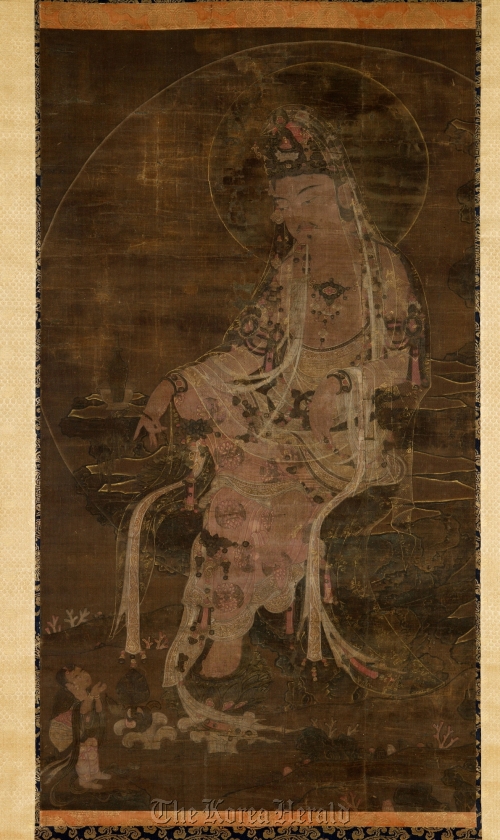German museums pull out 116 artifacts from their Korean art collections for traveling exhibiti
A two-year touring exhibition of Korean art and cultural artifacts in Germany will kick off Friday at the country’s Museum of East Asian Art in Cologne.
The exhibition “Korea Rediscovered ― Treasures from German Collections” is co-organized by the Linden Museum in Stuttgart, Germany, and the Korea Foundation which found it a pity that Korean relics are rarely exhibited in German museums despite their voluminous collections.
Germany has the largest collection of Korean artwork in Europe, a continent where there is relatively little interest in or familiarity with Korean culture. The country has at least 10 museums that have Korean art collections which are known to house more than 6,000 Korean artworks and relics.
The relics, however, were tucked away deep in storage because there were few Korean art experts in Germany who realized their value.
“When I visited the Museum of East Asian Art in Cologne in December 2008, which opened a Korean room in 1995 with the support from the Korea Foundation, it was holding a special exhibition on Chinese art in the Korean room. I was also disappointed to see the poorly exhibited South and North Korean sections at the Grassi Ethnological Museum in Leipzig in January, 2009. The situation was similar in many other museums ― they had many Korean relics but hardly exhibited them,” said Min Young-jun, head of the Korea Foundation’s Berlin office.
“First, the size of their Korean collections are too small, only about one tenth of Chinese or Japanese collections. Moreover, they did not have much knowledge or interest about Korea nor understood the value of their Korean collections. That is why they did not display the Korean artifacts, needless to say hold an exhibition.”
 |
“Suwol Gwaneum,” or “Water-Moon Avalokitesvara painting” from the Goryeo Dynasty. (Korea Foundation) |
This exhibition aims to break down such barriers and introduce Korean art not only to the public but also to curators so they can organize such exhibitions in future. It will stop at four cities ― Cologne, Leipzig, Frankfurt and Stuttgart ― with 116 items straight from the German museums’ own collections.
Ten different museums ― Museum of East Asian Art in Cologne; Linden Museum in Stuttgart; National Museum of Ethnology in Hamburg; Museum of Art and Crafts in Hamburg; Museum of Ethnography in Leipzig; Museum of Applied Arts in Frankfurt; Gutenberg Museum in Mainz and Mission Museum in St.Ottilien ― opened their collections to contribute to the show.
Subtitled “A Journey Back in Time” by the exhibition’s head curator Ken Vos, former curator at the Ethological Museum in Leiden, the exhibition introduces Buddhist paintings, folding screens, mother-of-pearl objects, celadons and more from the Three Kingdoms period (first century BC-AD seventh century), the Goryeo Dynasty (918-1392) and the Joseon Dynasty (1392-1910).
Most of the exhibits were bought and brought to Germany by diplomats, missionaries and businessmen who visited Korea in the 1900s.
Among the more noteworthy pieces are the 12 “masterpieces,” which include “Suwol Gwaneum,” or “Water-Moon Avalokitesvara painting” from the Goryeo Dynasty, “The folding screen of peonies” by Joseon-period artist Heo Ryeon, and lacquer boxes inlaid with mother-of-pearl, also from the Joseon Dynasty.
 |
“The folding screen of Peonies” by Joseon Dynasty artist Heo Ryeon. (Korea Foundation) |
They are exceptional because at least 90 percent of all Korean objects in Germany represent the daily life in the late 19th and the early 20th century Korea and only 10 percent can be referred to as masterpieces, according to Maya Stiller, a Korean art expert who participated in the publication of the exhibition’s catalogue.
The extensive catalogue that discusses the cultural relations between Korea and Germany and explains how Korean artworks were acquired by German art collectors will be published by the Korea Foundation in German and English.
The exhibition runs from March 25 to July 17 at the Museum of East Asian Art, Cologne; from Feb. 17, 2012 to May 27, 2012 at the Grassi Ethnological Museum, Leipzig; from June 28, 2012 to Sept.9, 2012 at the Museum of Applied Arts, Frankfurt and from Nov. 17, 2012 to Feb. 17, 2013 at the Linden Museum, Stuttgart.
For more information, visit www.kf.or.kr.
By Park Min-young (
claire@heraldcorp.com)








![[Today’s K-pop] Blackpink’s Jennie, Lisa invited to Coachella as solo acts](http://res.heraldm.com/phpwas/restmb_idxmake.php?idx=644&simg=/content/image/2024/11/21/20241121050099_0.jpg)
